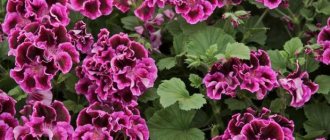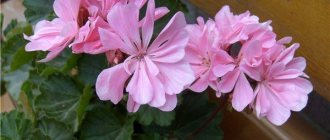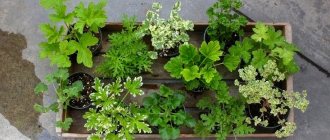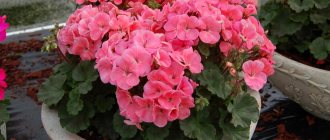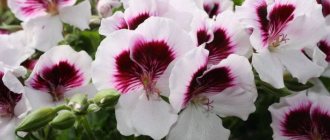Ampelous geranium (pelargonium) is a group of perennial plants that can grow both outdoors and indoors. The flower's homeland is tropical Africa. It differs from zonal geranium in the arrangement of branches, which fall down as they grow. In Russia, one variety is popular - geranium ivy (thyroid). It has been known in gardening for more than 300 years, mainly planted in flower pots.
Ampelous pelargonium: home care
In order for a flower to please with its healthy appearance all year round, it needs to create conditions suitable for life. And for this you need to know what the requirements of ampelous geranium are (care and cultivation, pinching), the characteristics of each growth period.
Ampelous geranium
Summer care
Active growth of geranium lasts from early spring to late summer. At this time, home care for pelargonium should consist of:
- timely watering. You need to moisten the flower when the top layer of the substrate gradually dries out. You can overdo it in this matter; you can’t water it very often, the flower won’t be grateful for it. So you should always keep watering under control, watching the ground;
- periodic feeding;
- pinching new shoots and pruning.
Ampelous pelargonium
Winter care
Caring for pelargonium in winter and summer is different. Unlike the warm period of the year, in cold weather the ampelous geranium rests.
Note! This time is very important for her, because how strong the flower will be during the period of active growth depends on how the winter goes.
Proper care of geraniums in winter is:
- location of the flower in a cool place (temperature approximately 5-12 ° C);
- diffused but bright room lighting;
- water rarely, about once every 2 weeks;
- Pelargonium pots should be located far enough from radiators and other heat sources.
Why doesn't the royal geranium bloom?
Many novice gardeners wonder why royal geraniums do not bloom. This may be a consequence of improper care, frequent transplants and the presence of bacterial and fungal infections. First of all, carefully inspect the plant for dark spots on the leaves, fuzz on the stems and rot in the root part. If signs of disease are found, then the entire root system should be cleared of soil, rinsed under running water and placed in a weak solution of potassium permanganate for 2 - 3 days. Clean or remove all affected parts of the plant.
Prepare fresh soil. If the same pot is to be used, disinfect it with a bleach solution. Before replanting, also disinfect the soil with boiling water. Replant the plant and carefully monitor the appearance of new signs of disease.
Also, royal geranium does not bloom if improper care and growth conditions are provided. For example, excessive dry air leads to the systematic falling off of buds and flower stalks. Their formation occurs only if the soil contains sufficient quantities of phosphorus, potassium and manganese. If nitrogen is applied in excess, green mass quickly increases and there is no flowering.
Another option why royal geranium pelargonium does not bloom is that the container in which the plant grows is too large. For this indoor flower, tall, but not wide, pots are more suitable. This ensures long-lasting abundant flowering. A large pot leads to the growth of green mass and lack of budding.
Features of growing ampelous pelargonium outdoors
How to propagate ampelous geranium at home
Pelargonium feels great both indoors and outdoors. Therefore, ampelous geranium is often planted in the ground. The requirements for a flower planted outdoors remain the same as for care at home. For lush flowering and healthy growth, it needs watering, fertilizing and periodic pruning.
Ampelous geranium on the street
Selecting a location
The most important thing for planting geraniums outside is the composition of the soil. It is the well-chosen soil that will give strength to the flower. The soil must be free of stagnant groundwater, this way the roots of the flower will be protected from rotting.
For your information! Another important point is that geranium does not like clay and loamy soil, so places with such soil are not suitable for planting a flower.
Lighting
Ampelous geranium prefers very bright places. Thanks to the sun, pelargonium begins to bloom profusely, otherwise the buds fall off and only the stems begin to grow. It is important to take into account that, like many other flowers, ampelous geranium does not really like direct sunlight, so the place should be moderately lit and hidden from direct sunlight.
Temperature
During the flowering period, ampelous geranium should be in a warm place. The best temperature for this flower is approximately 18 °C. However, the plant is not afraid of cold weather, so there is no need to worry about the winter period.
Important! Since pelargonium most often hangs down from the pot, spreading its leaves, you need to choose a place for the flower so that its branches are not deformed by the wind.
Preparing for winter: pruning
Preparation for the dormant period begins in the fall, and the most important thing to do is to prune the geranium. This will subsequently have a huge impact on how it will bloom. Without pruning, even if all the necessary conditions outlined below are met, such lush and beautiful flowers will not appear on the plant.
Procedure for pruning geraniums:
- At the end of September, absolutely all flower stalks are cut off, regardless of whether they have faded or are still actively doing so. This is done to help geraniums preserve their reserves of resources for the winter.
- All leaves that have already turned yellow and withered or have just begun to do so are plucked off or cut off. Experienced gardeners recommend pinching them off rather than cutting them with scissors. In the second case, mere protruding roots remain.
- For dense flowering in September, geranium is pruned so that the beginning of the branches remains, or just above (3–5 cm) the node. The upper cut part can be rooted as a cutting.
You need to prune the plant until it loses its beautiful and lush appearance. If the plant is young, then it is only pinched , and this is done according to the following rules:
- Pinching of young plants begins when their height reaches 5–6 cm.
- After the geranium grows another 5 cm, pinching is done again.
- To achieve a spherical shape, you can pinch it 3 times in a similar pattern.
In this case, pruning can be done both in autumn and in spring, it depends on the variety of geranium. For example, zonal geraniums tend to grow, and if this does not bother you at all, then you don’t have to prune them, but it’s better not to touch very small plants until spring.
For variegated varieties, pruning is very stressful, so it is better to prune them in the spring. You only need to trim the hanging ones when they grow too much.
Important! Flowers and yellowed leaves must be removed in any case, regardless of the variety, while trimming the stem is individual for almost each variety, which differ in size.
For small geraniums, pruning will not play a big role, but for those that are large, it is very important.
The most common pests and diseases
Unfortunately, like almost every flower, geranium is also subject to some diseases, sometimes even pests appear on the plant. If not properly cared for, geraniums can be affected by gray mold, viral mosaic, various harmful fungi or caterpillars.
Royal geranium - home care for beginners
Only chemicals that are sold in specialized stores will help solve the problem. But, in order to prevent this state of geranium, it is easier to care for it properly.
Note! Infection can be caused by overwatering, insufficient lighting or improperly selected fertilizers.
Common species of the genus
There are about 250 species in the genus Pelargonium.
The most common types in Russia are:
- Zonal.
- Royal.
- Variegated.
- Fragrant.
- Prickly.
But only ivy-leaved (ivy-shaped) or ampelous pelargonium has the ability of shoots to hang or creep. The plant acquired this name due to the external similarity of the leaves of this type of pelargonium to ivy leaves (five-lobed, hard and smooth).
The word "ampel" translated from German means "hanging flower vase" . Hence the interchangeability of names: they all name a plant whose shoots are capable of trailing, like ivy shoots, so it is advisable to grow them in hanging pots or flowerpots. However, some landscape designers use ivy pelargonium as a ground cover crop.
Feeding ampelous pelargonium for lush flowering
Bacopa ampelous - growing and care at home
During the flowering period, geranium needs feeding. You can help the flower during this period with the help of various fertilizers, which are added to the soil throughout spring and summer.
In this case, a complex of mineral fertilizers comes to the rescue. Also, flower growers sometimes use milk as a top dressing. But you should be careful; first, just like other fertilizers, it must be diluted with water.
Lush flowering of ampelous geranium at home after proper care
Important! Organic fertilizer is not suitable for hanging geraniums.
For fertilizer purposes, substances such as phosphorus, potassium and magnesium sulfate are also used, which also need to be diluted with water.
Appearance and flowering characteristics
A special feature of ampelous pelargonium is its flowing shoots, the length of which can range from one to one and a half meters. The shoots can curl along walls or hang down spectacularly, so the plant is actively used for vertical gardening.
The color palette of inflorescences is diverse: ampelous pelargonium flowers can be white, lilac, scarlet, red, pink. The tone can be uneven: there are varieties with flowers that are speckled, striped, with a border and spots. Flowers can be simple or double .
The duration of flowering for each is 5–6 days. Flowering time is from mid-spring to mid-summer. The glossy leaves of the plant are five-lobed, their width is 3–6 cm. Their color is interesting: depending on the variety, it can be rich green or white-variegated.
In the 18th century, flower growers and breeders in England and the Netherlands developed a plant species that was very similar to African pelargonium. It was called geranium. Carl Linnaeus, in his treatise “The System of Nature,” combined them into one genus. But African and European plants have different flower structures and other differences, therefore, in the modern classification, pelargonium and geranium are representatives of different genera. Hence the confusion in many information sources, which mistakenly replace one name with another.
Geranium and pelargonium are two different plants!
Pruning and shaping the bush
Why do you need to prune geraniums? This question is most often asked by novice gardeners, because the flower is already growing, why break it off? Pruning pelargonium is necessary so that the bush has a neat appearance. It also helps the flower not to waste extra effort on stretching it to unnecessary lengths. Thus, the plant gives all its energy to flowers and lush leaves. In addition, pruning allows you to obtain cuttings for flower propagation.
Trimming
Important! Pruning can only be done on an already mature bush. Young plants may be damaged by this method of creating a flower shape.
All about pruning and pinching pelargonium
The main difference between pruning and pinching is that the former is considered a drastic way of changing the shape of a plant by removing entire branches. This is necessary so that the flower is formed in the form of a bush, otherwise, if pruning is not done and the flower is allowed to grow the way it wants, the branches will stretch out, and the plant itself will produce a minimum number of flowers.
In the second case, only the tips of the stems, namely the growing points, are pinched. The advantage of this method is that over time, not one, but several young shoots appear at the pinching site. In this way, you can achieve greater splendor and bushiness of the flower.
The most important thing when pruning and pinching:
- use the right tools. For pruning plants, only a sharp tool is suitable, which will not unnecessarily harm the flower;
- wash or disinfect your hands before the procedure so as not to infect the flower with diseases.
The plant needs to be trimmed before each wintering. In this way, the geranium will be able to maintain its strength during the cold period and bloom magnificently in the spring.
Pinching, in turn, is a procedure that is best carried out at the end of winter or early spring, but forming a bush is not prohibited at a later time, when the plant is already blooming.
Important! If there are diseased shoots on the flower, then pinching them is useless. In this case, it is better to cut the branch. This will keep the rest healthy.
Reproduction
Ampelous pelargonium can be propagated using seeds and cuttings. The first method of growing is more labor-intensive, the second is suitable for beginners.
Cuttings should be carried out in spring or late autumn, when geraniums are prepared for wintering. It is necessary to trim several shoots from 7 to 10 cm long. They should have 3-5 leaves. Too many leaf blades will prevent the plant from taking root, since all the nutrition will go to them. If necessary, you can trim 1-2 leaves.
It is important to prepare cuttings correctly. They are very sensitive to moisture and can quickly rot. To avoid this, you need to dry them for 5-6 in the sun or under a phytolamp if the gardener carries out cuttings in late autumn. Sprinkle the cut with ash or crushed coal, and prepare the soil at the same time. The correct composition includes:
- sand;
- turf land;
- peat.
Proportion – 1:1:1. The earth mixture should be mixed well, but not compacted too much. It should be loose so that moisture does not accumulate and cause the plants to rot.
After drying, the cuttings should be planted in a container with prepared soil and lightly compacted around each sprout so that it does not tilt. Watering should be done carefully as the soil dries. 2-3 weeks after planting, the cuttings will already have a fairly strong root system, and they can be planted in separate pots. It is recommended to do pinching to form a bush.
Propagation by seeds is more complex, labor-intensive and time-consuming. Experienced gardeners should switch to it. This method is used as part of landscaping, if you need to get as many sprouts as possible at minimal cost.
Pelargonium seeds are quite strong and have a hard and thick skin. Before planting, which is best done in late February or early March, they need to be prepared:
- Using medium sandpaper or a nail file, sand off the peel layer, being careful not to touch the inner contents. This will allow the sprout to hatch faster.
- Leave the seeds in the water for 24 hours.
- Disinfect using a solution of potassium permanganate, then dry each specimen.
These steps are not necessary, but they will increase germination. Not all seeds are of high quality, so the gardener needs to be prepared that some of them will not sprout.
For seeds you need to prepare the same soil mixture as for cuttings. Seeds need to be planted in loose, well-moistened soil, with a depth of only 5 mm. Then sprinkle. Place the container under film or in a mini-greenhouse for 10 days, maintaining the temperature at 22-24 degrees. After germination, the film can be removed. During this period, it is important to provide plenty of light. Experienced gardeners recommend supplementing the sprouts with a phytolamp. When each young plant has 3 true leaves, planting in separate containers is allowed.
Growing pelargonium yourself
Growing a flower is always a fascinating process, especially if the plant was not originally purchased in a store, but planted yourself. Growing geranium can be done by propagating the plant by cuttings or using seeds.
Germination
Growing from seeds
The most favorable period for geranium seed germination is December to April. The procedure consists of several stages:
- For the soil, use a mixture of peat, sphagnum, garden soil and sand.
- The prepared soil with seeds must be moistened and placed under a film to form a kind of greenhouse.
- It is worth storing the flowerpot with seeds in good lighting. The room temperature should be 22-24 °C. Under these conditions, the seeds begin to germinate in about a week.
- After waiting 3 weeks, you can pick the sprouted seeds.
How to grow from cuttings
To propagate pelargonium by cuttings from a ready-made bush, you need to cut off a branch. It is best to do this in the summer. The cutting can produce roots in water or directly in the ground. After the shoots have rooted and several leaves have appeared, it is recommended to pinch them. This way the bush will gradually grow and become more magnificent. If you care for the cuttings in the right way, within a year the sprout will delight you with flowers.
Need for pruning
Pelargonium is pruned regularly; the choice of season (spring or autumn) is determined by flowering time and variety. This is necessary for:
- obtaining fresh shoots;
- variety propagation;
- formation of an even and dense crown;
- improving air exchange.
At the same time, old dry branches, shoots growing in the direction of the stem and interfering with each other, branches that lack foliage and inflorescences are removed.
Autumn pruning is more reasonable than spring pruning. At this time, the geranium is preparing to rest. The process prepares it, facilitates wintering, and promotes lush flowering in summer.
Transplanting pelargonium
Replanting greatly affects the health of the flower. It is best to carry it out in early spring. This procedure is most often performed to increase space for the flower. Thus, a pot with a diameter of 1.5-2 cm larger than the previous one is better suited for replanting. Planting pelargonium requires care and attention, so you should be careful.
Important! Expanded clay should be placed at the bottom of the new pot so that excess moisture does not remain but evaporates.
Homemade ampelous pelargonium is becoming one of the favorite flowers for housewives not only because it blooms very beautifully, but also because it is undemanding in care. In order for the flower to always remain lush and beautiful, you just need to be careful and follow simple but important rules for geraniums.
Description and price
Ampelous pelargonium is a perennial plant of the Geraniaceae genus .
A special feature of this type of plant are long shoots and umbrella-type inflorescences in the form of one bunch, consisting of 5 – 15 flowers. The inflorescence is located on a long peduncle, the diameter of the inflorescence is 8-10 cm. The leaf blades of pelargonium have a palmate-lobed shape. The homeland of ampelous pelargonium is the Cape Province of South Africa, where it naturally cascades down the hillsides. In the 17th century it was brought to Holland, and from there the flower spread throughout Europe already in the 17th and 18th centuries. The pricing policy for those wishing to purchase this plant looks like this:
- in Moscow, rooted cuttings of ampelous pelargonium, which do not require replanting, are sold for 450 rubles. per piece, and the price for an adult plant can reach 800 rubles;
- in St. Petersburg, a rooted cutting costs 250–300 rubles, an adult plant – 450 rubles.
Possible problems in growing
Even the most experienced gardeners are not one hundred percent protected from the problems that arise when growing royal geraniums. It's even more difficult for beginners.
Drops buds and leaves
If the leaves and buds of the royal geranium begin to fall off, then with a high probability we can say that the room is too hot and the air is very dry. Also, these symptoms sometimes indicate insufficient lighting. You will need to turn on the phytolamp, install a humidifier and take measures to reduce the temperature in the room. If the house is cool, then it is enough to limit yourself to additional lighting and monitor the humidity.
Due to the heat, the royal geranium sheds its leaves and buds
The leaves are turning pale
A change in the color of the leaf blade is provoked not only by a deficiency of microelements (in particular nitrogen), but also by a lack of light, as well as excess moisture. It is urgent to analyze these factors and eliminate the cause.
The tips of the leaves are drying out
This problem in royal geranium most often occurs due to moisture deficiency. You should increase the number of waterings and resort to air humidification, but you should not be too zealous.
The lower leaves fall off
The fact that the lower leaves begin to turn yellow and fall off is caused by both a lack of moisture or nutrients in the soil, as well as a lack of light and poor ventilation of the bush. This symptom also signals rotting of the root system, which can lead to the death of the flower.
Pests
The most dangerous pests for royal geraniums are:
- mite;
- weevils;
- whitefly;
- aphid.
Royal geranium is susceptible to pests
To get rid of parasites, you should wipe the inside of the leaf blade with chamomile infusion and leave the plant for a couple of hours, then rinse everything off. If such actions do not bring a positive result, use an insecticide. Step-by-step instructions for its use are contained in the attached documentation.
Other problems
Sometimes the trunk of the royal geranium begins to rot. This indicates that the plant is affected by blackleg. The development of this disease is caused by excessive watering or low temperatures. Sick plants need to be disposed of and the pot disinfected.
Sometimes gardeners wonder why geraniums are green but lethargic? First of all, you should immediately reduce watering. Otherwise, the flower will bleat with gray rot. The scarlet tint of the leaves indicates low temperatures or the presence of drafts.





